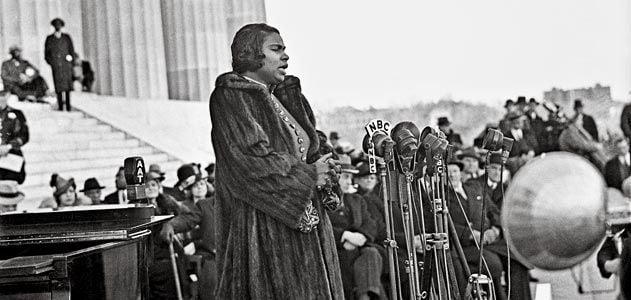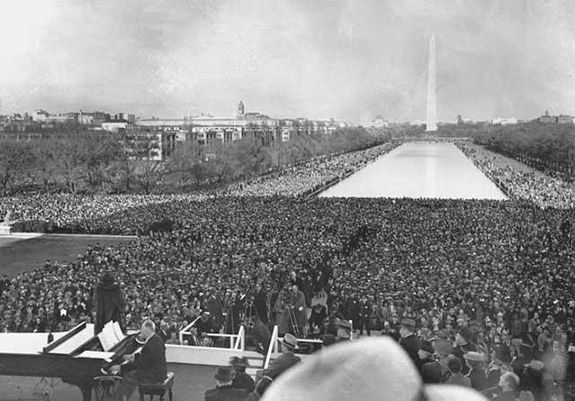Marian Anderson: Freedom Singer and Mentor To Generations
How a gifted black singer transformed opera and the nation through a lifetime of giving
/https://tf-cmsv2-smithsonianmag-media.s3.amazonaws.com/filer/81/c8/81c8d2f2-c6d6-4467-85b2-b47d39bf5e81/1280px-eleanor_roosevelt_and_marian_anderson_in_japan_-_nara_-_195989.jpg)
“Writing about Marian Anderson coming to grips with the meaning of her life was one of the joys of my life,” Arsenault told a group of 50 people attending “Voices of Change, Sounds of Freedom,” a biannual forum presented by the Humanities Council of Washington, DC.
Throughout the discussions, the diva’s presence loomed large. Thanks to a documentary, Marian Anderson: Voice of Conscience, presented by WETA, featuring interviews with her at age 94, as well as Arsenault’s groundbreaking book, which illuminates Anderson’s life and career, her resilient spirit is more fully emerging.
“I was interested in her primarily as a civil rights icon and how she changed America,” says Arsenault. But the depth of her significance as a mentor and role model, he says, while not unexpected, was surprising. Rising from humble beginnings in Philadelphia, Anderson managed to learn five languages, develop a three octave range and exude constant grace in the face of persistent prejudice.
By 1939, she was a global star managed by Sol Hurock, who made her the third biggest box office draw in the nation, attracting crowds of 5,000 or more.
“At that time, Washington was the only large city in the U.S. without a municipal auditorium,” says Arsenault. Howard University sponsored annual concerts with Anderson but had no campus venue large enough for her growing fan base. University leaders sought out the much larger Constitution Hall venue, despite having been rebuffed in the past.
Segregating audiences, not concert halls, was a general practice in DC, says Arsenault. But following an incident at a Roland Hayes event, management at Constitution Hall halted black performances and adopted a “white artists only clause” to prevent the embarrassment of having too few black seats in the house to meet the growing demand of music-loving black patrons, even as the seats reserved for whites only remained empty.
After several refusals, Howard leaders asked the DC School Board for permission to use the auditorium of a large white high school. There, they were also denied. Lafayette Park, located across the street from the White House, was considered, but ruled out because it was too small.
Assistant Interior Secretary Oscar L. Chapman emerged as a critical, though rarely acknowledged, advocate. He personally garnered the support of the White House, and President Franklin D. Roosevelt approved the use of the Lincoln Memorial grounds, even though the location had never been used for a public event. “If Chapman had not been there it probably wouldn’t have happened,” says Arsenault.
As the date of the concert neared an unexpected April storm turned the weather cold. No one knew if people would show up. Anderson had never sung outdoors. Two days before the concert, Anderson grew apprehensive. She backed out, but then relented under pressure from Hurock and Walter White, head of the NAACP.

“Amazingly 75,000 people showed up,” says Arsenault. It was a multiracial sign of unity. Black and white boy scouts passed out copies of the Gettysburg Address. NBC radio broadcast portions of the event, which has never been broadcast in its entirety.
Anderson later said she was paralyzed with fear. “When she opened her mouth,” says Arsenault, “she didn’t think anything would come out.” There was a delay, then America the Beautiful …my country tis of thee, sweet land of liberty, of thee I sing.
“Everyone had a sense that this was an incredible moment in American history,” Arsenault says. “People rushed the stage to touch her. Many commentators envisioned this was what America could be but wasn’t.”
Yet.
That night Anderson and her mother stayed at a private home before returning to Philadelphia. They’d been unable to find an area hotel to accept them.
Arsenault says there is a message to her story. “People have to perceive civil rights as a national or international problem. You can’t put it all on whites from the South. You have to get over that and see racism as a stain on the national honor before you can mobilize people on a national level,” he says.
“We need to look unblinkingly at our past. Otherwise we continue to make the same mistakes,” he adds. Marian Anderson’s story “shows the importance of historical knowledge.” However the full 30-minute concert, he says, is only available via the UCLA Film Archives and costs a whopping $25 a second to view.
In a 2009 tribute on the 70th Anniversary of the historic concert, opera star Dencye Graves celebrated Anderson’s legacy performing numbers from the historic concert. Graves was resplendent in a gown presented to her by the great diva.

Mining the past can yield unexpected treasure. For historian and author Ray Arsenault, whose book The Sound of Freedom delves into the back story of how the venue for a 30-minute concert became a much-treasured shrine of dignity and national unity, the gold dust is still there.
The concert is the pivotal 1939 performance where the African American artist Marian Anderson sang on the steps of the Lincoln Memorial and moved a nation. The lesson, Arsenault says, is how Anderson’s talent and grace created a moment that transformed a populace grappling with race, not just in the deep South, but everywhere.
Throughout her career Anderson had amassed supporters worldwide, performed before heads of state and inspired impresarios like Arturo Toscanini to proclaim her contralto to be a voice that emerges only “once in 100 years.” But Arsenault says there is more to her legacy. The much-acclaimed performer opened the doors and offered classical music careers to future generations of black divas, personally providing support to budding ingénues, like Grace Bumbry and Shirley Verrett, out of her own pocketbook.
/https://tf-cmsv2-smithsonianmag-media.s3.amazonaws.com/accounts/headshot/Joann_Stevens.jpeg)
/https://tf-cmsv2-smithsonianmag-media.s3.amazonaws.com/accounts/headshot/Joann_Stevens.jpeg)